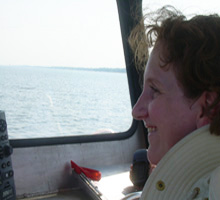 Purdue University - Extension - Forestry and Natural Resources
Purdue University - Extension - Forestry and Natural Resources
Carolyn J Foley

Forestry and Natural Resources
Research Coordinator
Phone:
765.494.3601
Fax:
765.496.2422
Office:
FORS Room 203
Address:
Illinois-Indiana Sea Grant
195 Marsteller Street
West Lafayette, IN 47907-2033
195 Marsteller Street
West Lafayette, IN 47907-2033
Email:
Why Extension?
Tell us about your background?
I grew up in southern Ontario, where the Detroit River empties into Lake Erie. I have an undergraduate degree in Biology from the University of Windsor, a Master’s degree in Entomology from Purdue University, and I love to travel. I tell people who ask that I work with “fish and bugs”, but to be honest, aquatic invertebrates are my cup of tea. The really weird ones, like tardigrades, are the best.
How did you come to work in the Great Lakes? What do people need to know about them?
No matter where I went, the Great Lakes called me back. They’re one of the greatest sources of surface freshwater on the planet, and support high numbers of jobs, healthy ecosystems, and strong tourism and recreation. Not to mention, they are stunningly beautiful. Southern Lake Michigan in particular is facing a lot of stressors. High population density, new invasive species, runoff that contains unwanted chemicals or sediment, and flooding are four major issues. But the toolkits available for facing these and other issues are growing every day.
How did you get involved with FNR Extension and outreach?
I started working for Illinois-Indiana Sea Grant in 2010 after working for a few years in Tomas Höök’s fisheries lab. My main job is to help coordinate the research program, but I also share information with a wide variety of people. In addition to outreach events like Purdue’s Springfest or local boat shows, I coordinate meetings for academic researchers to make sure they have access to the latest data and are working together to answer big questions, and I help run the Illinois-Indiana Sea Grant real-time monitoring buoy program.
What do you enjoy most about your work?
I love finding new and interesting ways to share data. I also really enjoy hearing from the people who use our information, and trying to find ways to better suit their needs. It’s fantastic to hear, for example, that a sailor from Indianapolis knew that they shouldn’t bother making the trip up to Lake Michigan for the day because they were able to check one of our buoys in the morning, or that a group of researchers were able to get a grant funded because of a workshop we hosted.
What is the biggest challenge you face in your job?
Making sure people know about us as a resource. Word of mouth helps us out a lot, as we tend to have cool displays and good information being shared at the outreach events we take part in.
What part of your job did you least expect to be doing?
Twitter. @TwoYellowBuoys and @IISGResearch are two of the handles I help manage.
Do you have an outside hobby?
I like to crochet. I think the best things I ever made were tiny Yoda hats for premature babies.